Executive chef Justin James has international ambitions for Restaurant Botanic
If you’re dropping about $300 on lunch, per person – before the drinks – expectations are high. So the man in charge has very precise rules.
SA Weekend
Don't miss out on the headlines from SA Weekend. Followed categories will be added to My News.
‘Sometimes I sit here and go, ‘Botanic, what’s out there?’ Wood chips, wood chips, how can I do wood chips? Wood chips, what do I do in wood chips? Do I hide something in wood chips? Grass. Can I do grass? What’s grass, can you eat grass? I don’t know. Can I serve something in grass? Flavours of grass? What are flavours of grass? Sorrell, wheatgrass … what are trees, what leaves are out there – sticks, there’s sticks, there’s limbs, there’s branches …”
The creativity cogs are spinning in executive chef Justin James’s head as he describes the inspiration behind new dishes at his Restaurant Botanic. The stakes are high. Within 18 months of reopening the Adelaide restaurant with a new name, fit-out and kitchen team, Restaurant Botanic was named Australia’s Restaurant of the Year 2022 by Gourmet Traveller and the best restaurant in South Australia by delicious.
This year, it received the lauded three hats from goodfood.com.au – the highest ranking for the publication.
And it’s only just the beginning.
“Do we want to be on the 50 World’s Best (list)? Absolutely,” says James, who turns 37 next month.
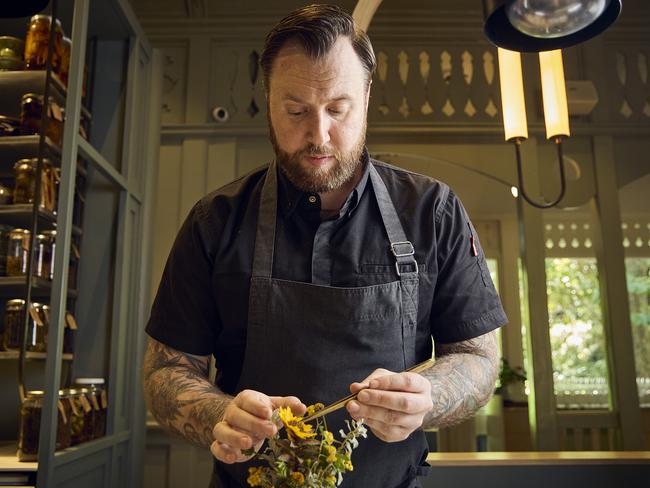
“I feel like I need to give it a few good years and what it takes is patience, consistency, not being complacent … and having fun.”
Raised on a small farm in Michigan in the US, James is a world away from home. But he’s carving something special from within the Adelaide Botanic Gardens.
His hours-long degustation of what he calls “flavour combinations”, with ingredients sourced from the garden’s bounty, has earned him rave reviews and national fanfare. Restaurant Botanic is the most talked about restaurant in the country right now.
We’re chatting in the dining room, three hours before dinner service. James sits with his laptop, spreadsheets and notepad, while his team begin food and service prep.
Flames rear to glowing peaks at the back of the kitchen, while on the dining room floor, staff align napkins and chairs to particular degree. Each and every wine glass is raised to check for water marks – the rare imperfect one, put aside.
On James’s screen, graphs reveal bookings for the weeks ahead (the 36-seat restaurant is fully booked for the coming month), while another window opens a website that sells … women’s scarfs.
“We sometimes get a draft so I want to have scarfs for when diners get a bit chilly,” James says. “It’s always good to be proactive rather than reactive.”
His most important task right now is writing The Brief. He scrawls a list of talking points on his pad to relay to his staff. “It sets the tone and really motivates the team to make sure we’re on the same page,” he says.
“Sometimes they’re 20-30 minutes long, sometimes they’re 10 minutes long. Last night we had a table of diners who said they had an exceptional world-class experience and I like to share that with the team. It might be little things to work on, like the fish needs to be smoked more … sometimes it’s more personal about how I’m feeling. When you make yourself more real, it goes a long way.”
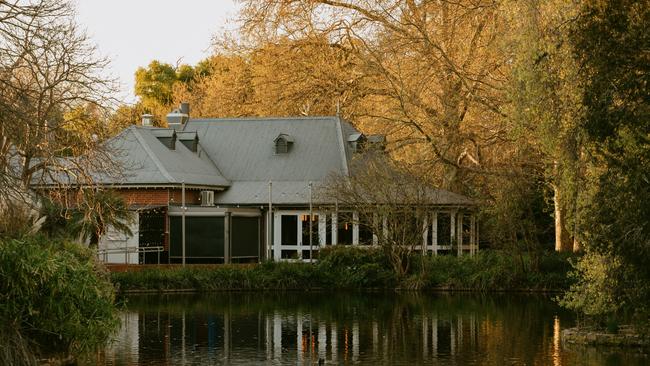
There’s a clear sense of respect and high morale among the team. There’s no tension; no hot pans being thrown – this is no reality TV show or Netflix drama. For James, motivating his team is paramount, as is keeping his kitchen organised. From to-do lists to neatly labelled containers, it’s a not-so sexy part of running a successful restaurant.
“The biggest thing I have learned as a chef working at a world-class level is, don’t worry about the food,” he says. “Worry about everything else.
“To provide something exceptional, you have to do all the little things exceptionally well. Sometimes it’s nothing to do with the cooking or serving or pouring – it’s about how you cut the labels; how you organise the dry goods; it’s about how you put food away; how you keep your section.
“If you can do all those things really well, then you can cut the onion, you can cut the duck, you can cut the marron really well.”
Did he always have a tendency to keep things just so? “Yeah,” he says. “Big time. My Hot Wheels and GI. Joes were always lined up. That’s where (I learnt) what also counts is if you’ve got nice things, to look after them.”
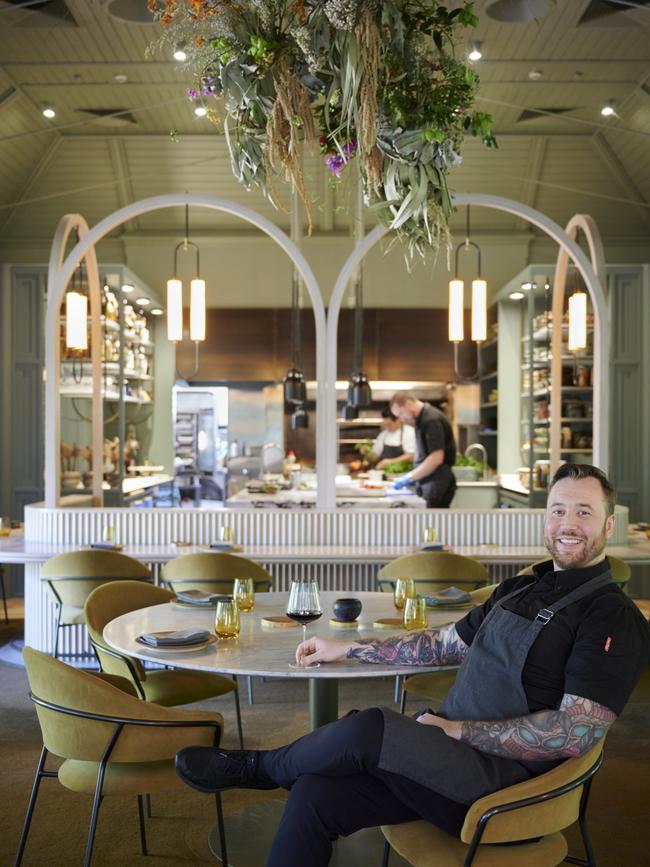
Restaurant Botanic indeed has nice things. Handmade buffalo spoons worth up to $200 each. Chairs, $900 each. Crockery is custom made, designed by James himself.
It’s no surprise, then, that James and the team count every single piece of servingware at the end of each service. Thinking about pocketing a souvenir? They’ll know about it. Apparently paying upwards of $300 a person for a meal, not including drinks, gives the occasional diner sticky fingers.
While he was interested in cooking from a young age, and held restaurant jobs from the age of 16, pursuing the chef’s path wasn’t always on the cards for James.
He went to Michigan State University, where he studied chiropractic medicine before switching to civil engineering. His father, too, was an engineer.
“Basically I wanted to control the traffic lights,” he says. “So that if you did the speed limit and the distance, they would turn green-by-green-by-green. ”
Outside of uni, James had become sous chef at a Chinese restaurant. His love for one part of his life outweighed the other.
“As I was going (studying), I was like: I just want to be a chef.”
While Dad didn’t approve of his career change at the time, James’s pursuit of cooking cemented a love he’d nurtured from a young age. “I was cooking Thanksgiving dinners when I was in year 7 or 8,” he says. “I think I just love eating, and I also love doing things with my hands. I love the fact you can create things, then you can eat it. But there’s a lot more to it – it’s about making people happy.
“My first cookbook was Cooking for Dummies. My dad still jokes about that.”
After shelving his degree (he had switched from engineering to food management by this point), James joined culinary school in Vermont, where he didn’t so much gain basic practical skills but rather, the golden ticket – a degree – to get his foot into Michelin-star restaurants.
That would include Eleven Madison Park – the pinnacle for many an ambitious chef, famously topping The World’s 50 Best Restaurants list in 2017.
“That was like getting a PhD,” James says of his four years at the New York icon. “Big city life, broke as f**k.
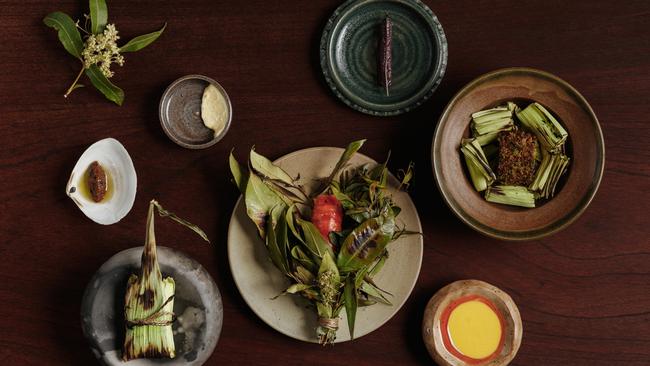
“That was where I learned to push the boundaries; season (food) … I was a very messy chef and they taught me to cook clean. It wasn’t the longest hours, especially back then, but what wasn’t physical, it was more mental, because it had to be perfect.
“I’ve learnt a lot of things and it’s deep in my DNA, but I put my own twist on it now.”
It’s difficult to imagine how James got from New York’s finest to the former tearooms of the Adelaide Botanic Gardens, South Australia. There were stops along the way. On a holiday visa, he spent several years at Melbourne’s esteemed Vue de Monde, progressing to executive chef. He moved to Copenhagen for a while, where he cooked at another former world No. 1 – Noma – before returning Down Under.
In January 2020, he moved to Brisbane for a group chef role. He was made redundant three months later: Covid had arrived.
“That was one of the biggest points in my life,” James says. “Those short three months made me realise I need to be in a restaurant creating, not sitting at a desk. I am a chef to the day I die.”
With a son in Melbourne, he returned to be with him for those many lockdown months.
When it came time for his next big move – to help build up a one-Michelin-star restaurant in Los Angeles – an unexpected opportunity arose: to take the reins at the then-named Botanic Gardens Restaurant.
James initially declined.
“But curiosity kills the cat,” he says. “I Googled that night, looked at photos, Google maps, TripAdvisor – I didn’t care about the reviews … I just wanted to see the bones.
“I saw the space and was like, you could do something really cool here. I called them back the next day and said, ‘here’s my idea’.
“I thought it was a risk coming here. I wasn’t sure what the demographic was, what was the demand, we were coming out of Covid … it was pretty ballsy just to renovate, put a significant amount of money into it, bring a new identity, a new brand, a new idea into here – I mean people told me not to do it. But if you build it, they will come.
“I wasn’t looking for this; this found me.”
Our conversation is paused briefly as a chef brings something for James to taste. “A little more koji in the capsicum,” he says. “A little more smoke on the fish.”
It’s almost time for the official menu tasting. Three hours (at least) of flavours crammed into 45 minutes.
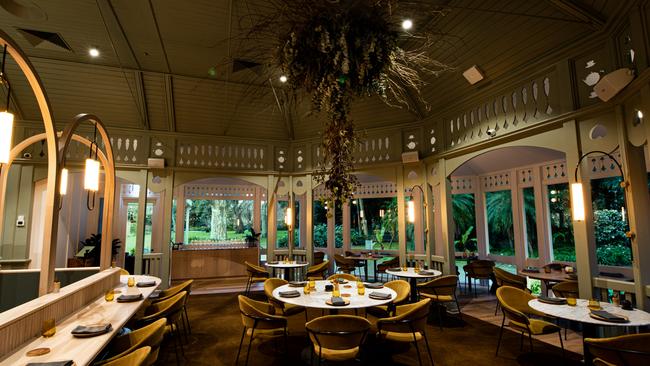
The restaurant smells pretty good now.
At 4.30pm, James steps into the kitchen for the procession. He tastes, pauses, thinks.
“Obviously we’re picking up salt; acidity, but it’s also about what remains on your tongue – how that’s going to feel in two hours (because) you can get palate fatigue,” James says. “Does it make sense with what you had before; what comes after?”
Solving this equation is what makes James tick. “What we do here is not just cooking food,” he says. “There are 26 flavour combinations right now – how do you organise that, how do you cook it, how do you serve it, there are four different wine matches – there’s a lot of stuff to work through. You’ve got to be super organised. I think that’s where the creative juices flow in me, which I absolutely love. There are endless opportunities and you can really do some magical stuff. You can really screw it up, too.”
Less is more, James believes. But simplicity isn’t, well, simple.
“We were working on this dish, kangaroo with onion glaze and herb oil from the garden,” he says. “The onion glaze takes two days to make. Then it was like, ‘oh we can add this, add that’ – then all of a sudden it’s too much. It comes down to: what’s the best thing? It’s this kangaroo with this glaze.
“When you try it, it’s like ‘f**k that’s delicious’. That’s what we’re gonna serve. But it takes years of experience to know that … to have the confidence to make that decision.
“You need to be a little bit crazy but also smart. The more creative you are, usually it pulls away from being super delicious … it’s a fine line. We’re not doing tomato, mozzarella and basil – I love a Caprese salad and margherita pizza – but we’ll never do that here. It’s tomato with mountain pepper, elderflower from the garden and native cherries. It’s duck with peach leaf and szechuan pepper from the garden. It’s grilled muntries tossed in black apple and duckshoot.”

With native ingredients, James treads a path few have done before. And he’s not the first out-of-towner to realise their potential. Ten years ago, it was outspoken Scot Jock Zonfrillo who elevated native fare to fine dining heights at his Adelaide restaurant, Orana (closed 2020).
But South Australia is in a different place now. Then, the concept of 20+ “courses” was crazy to most. Now, we have a restaurant serving up 26 morsels of flavour in a more relaxed environment interstate diners are repeatedly flying in for. Service is polished but unpretentious. Music is upbeat. A seat at the bar allows curious diners to watch chefs at work. James doesn’t like to identify it as “fine dining” but, rather, an “exceptional experience”. It costs $290-$330 depending on the day of the week (drinks and beverage pairings extra) and takes between three and four hours.
The time commitment can startle some.
“People have short attention spans these days,” James says. “Most people can’t even sit through a three-hour movie. Sometimes we just think we’re busy, but we’re not.”
The trick to keeping diners engaged, James says, is by involving them in the process. “Straight from the get-go there’s a (dish) that looks like a flower, from which you pluck the petals; there’s a wasabi rose little number that you fold up and eat; the tomatoes are in a bowl that has a lid on it … it could be as simple as picking up the bowl and feeling the roughness of the ceramic. Throughout the meal, there’s these little surprises. It starts conversation at the table or with yourself and I think that’s an important thing to have in a dining experience.”
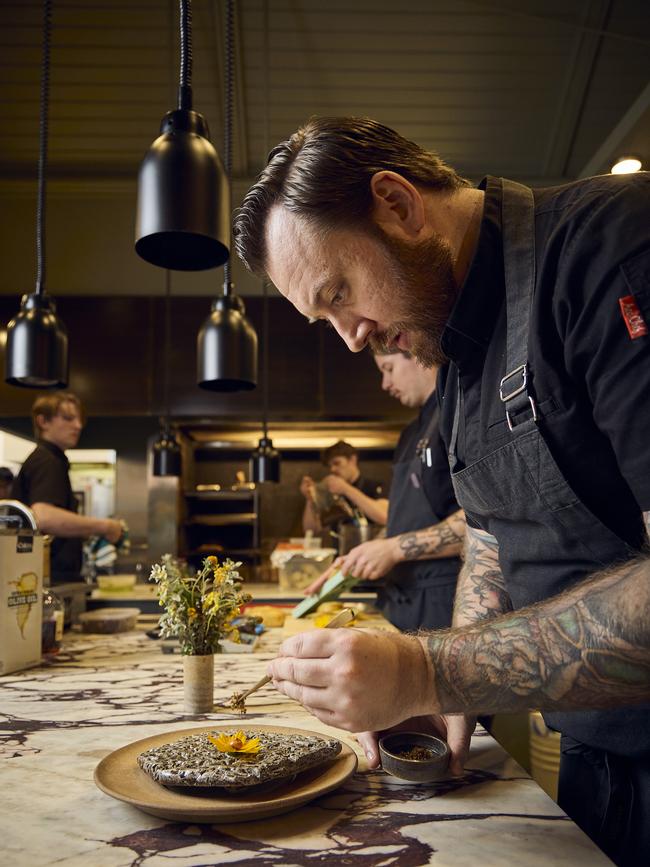

About the flower. To create that, fresh apple is marinated in parsley; other apples are fermented at 60C for three months. That’s blended, and spread thin to dry. The fresh marinated apple is wrapped with the fermented apple paste, then covered with nasturtium flower puree. Flower petals are painstakingly applied to that, then a pile of green ants are scooped into the middle.
It’s an homage to the Gardens and to Australia.
“The whole idea of this is to provide an Australian experience,” James says.
“This restaurant wouldn’t make sense 75 floors up in a skyscraper. This restaurant wouldn’t make sense in Singapore.
“I want you to taste the Garden, feel it and obviously see it, but also smell it. Sometimes you can hear it as well.”
It’s nearly 6pm and the anticipation is palpable for the first set of diners to walk through the door. Finally, a couple, welcomed with all the warmth one could hope for. The experience has begun.
James is at the top of his game and he’s playing it right here in Adelaide.
The question is, will he make history by attracting the World’s 50 Best Restaurants Academy to our Botanic Gardens, and earn South Australia’s first spot on the coveted 50 Best list?
“Being internationally known, I feel like we’re on the trajectory – we’ll get there,” James says. “If you make enough noise, people will come.”




